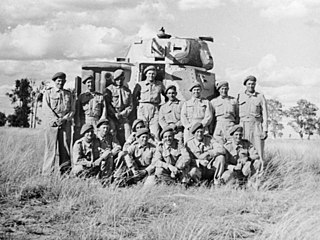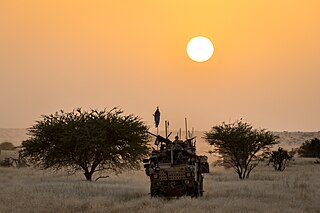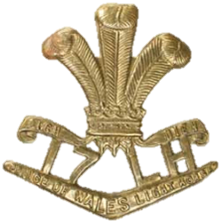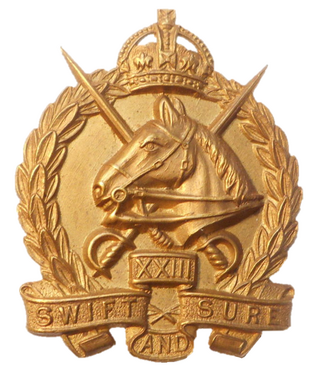A division is a large military unit or formation, usually consisting of between 10,000 to 25,000 soldiers. In most armies, a division is composed of several regiments or brigades; in turn, several divisions typically make up a corps.

Australian Light Horse were mounted troops with characteristics of both cavalry and mounted infantry, who served in the Second Boer War and World War I. During the inter-war years, a number of regiments were raised as part of Australia's part-time military force. These units were gradually mechanised either before or during World War II, although only a small number undertook operational service during the war. A number of Australian light horse units are still in existence today.

The Royal Australian Armoured Corps (RAAC) is an administrative corps of the Australian Army. It provides the Australian Defence Force's Armour capability, which performs the function of mounted combat. Armour combines firepower, mobility, protection and networked situational awareness to generate shock action and overmatch in close combat. Armour is an essential element of the combined arms approach that is employed by the Australian Army.
The Waikato Mounted Rifles (WMR) is the New Zealand Army's only Territorial Force squadron of the Royal New Zealand Armoured Corps (RNZAC). The Squadron's origins can be traced back to 1869 when the first mounted unit was raised in the Waikato. Today the Squadron is part of Queen Alexandra's Mounted Rifles (QAMR) where it forms the regiment's reserve squadron. WMR's role is mounted reconnaissance and surveillance.

The 3rd Armoured Division was an armoured unit of the Australian Army during World War II. Originally raised in 1921 as the 1st Cavalry Division, the formation had been converted into a motor division in early 1942, before adopting the armoured designation in November 1942. A Militia formation, the division undertook garrison duties in New South Wales and then Queensland and did not see combat before being disbanded in late 1943 and early 1944.

Armoured units made a relatively small, but important, contribution to Australia’s war effort during World War II. While Australia formed three armoured divisions and two independent armoured brigades during the war, Australian armoured units only saw action as independent regiments and companies supporting larger infantry formations. Early actions were fought in the Middle East by the divisional carrier regiments that supported the 6th, 7th and 9th Divisions, fighting in Libya, Egypt and Syria in 1941–42, before the Australian divisions returned to Australia in 1942–43. During the early fighting in the Pacific, there was a limited role for armoured formations, although one armoured regiment – the 2/6th – took part in the fighting around Buna–Gona in late 1942. Later in the war, though, during the Huon Peninsula, Bougainville and Borneo campaigns of 1943–45, several armoured units were used by Australian forces in the infantry support role.

There are 13 cavalry Regiments of the British Army each with its own unique cap badge, regimental traditions, and history. Of the currently nine regular cavalry regiments, two serve as armoured regiments, three as armoured cavalry regiments, three as light cavalry, and one as a mounted ceremonial regiment. There are also four yeomanry regiments of the Army Reserve, of these, three serve as light cavalry and one as an armoured regiment. Each yeomanry light cavalry unit has been paired with a regular unit of the same role, the armoured yeomanry unit is paired with the two regular armoured units. All except the Household Cavalry are part of the British Army's Royal Armoured Corps.

The 6th Australian Armoured Brigade was a formation of the Australian Army during World War II. The brigade was formed in May 1942, by the conversion of the 6th Motor Brigade and was assigned to the 2nd Motor Division. The brigade also absorbed units of the 5th Motor Brigade in June 1942. The brigade remained in Australia and did not see any active service before it was converted into the 4th Armoured Brigade in March 1943.
The 1st Motor Brigade was a formation of the Australian Army during the interwar years and the early part of World War II. Initially raised in 1921 as the 1st Cavalry Brigade in Queensland, it was a part time formation of the Militia. It consisted of three light horse regiments spread across several depots in the southeast part of the state. During World War II, the brigade was mobilized for defensive duties in December 1941, and assumed positions north of Brisbane to defend against a possible invasion. In early 1942, the brigade was converted into a motorized formation, and was redesignated as the 1st Motor Brigade. In July 1943, when the threat of invasion had passed, it was disbanded and its manpower reallocated to operational formations.
The 2nd Motor Brigade was a formation of the Australian Army during the interwar years and World War II. Initially raised in 1921 as the 2nd Cavalry Brigade in New South Wales, it was a part-time formation of the Militia. It consisted of three light horse regiments spread across several depots across the Hunter Valley and northern part of the state. During World War II, the brigade was mobilised for defensive duties in December 1941, and assumed positions along the northern coast to defend against a possible invasion. In early 1942, the brigade was converted into a motorised formation, and was redesignated as the 2nd Motor Brigade. In April 1943, when the threat of invasion had passed, it was disbanded and its manpower reallocated.
The 3rd Motor Brigade was a formation of the Australian Army during the interwar years and early part of World War II. Initially raised in 1921 as the 3rd Cavalry Brigade in Victoria, it was a formation of the part-time Militia. It consisted of three light horse regiments, which were spread across several depots in regional Victoria. During World War II, the brigade was mobilised for defensive duties in December 1941 to defend against a possible invasion. In early 1942, it was converted into a motorised formation and was redesignated as the 3rd Motor Brigade. The brigade moved to Western Australia in late 1942 and remained there until August 1944 when it was disbanded without having seen combat.

The 4th Motor Brigade was a formation of the Australian Army during the interwar years and the early part of the World War II. A formation of the part-time Militia, the brigade was formed in 1921 as the 4th Cavalry Brigade. At this time, it consisted of three light horse regiments based in southern and western New South Wales. During World War II, the brigade was mobilised for defensive duties in December 1941, and assumed positions along the southern New South Wales coast to defend against a possible invasion. It was converted into the 4th Motor Brigade in March 1942 when it was motorised. As a motor brigade, the 4th undertook defensive duties on the south coast of New South Wales before it was converted into an armoured formation, designated the 3rd Army Tank Brigade in May 1942.
The 5th Motor Brigade was a formation of the Australian Army during the interwar years and World War II. A formation of the part-time Militia, the brigade was formed in 1921 as the 5th Cavalry Brigade. At this time, it consisted of three light horse regiments based in Victoria. The brigade ceased to exist in 1936 due to manpower shortages, but was re-raised during World War II, in April 1942, as a motor brigade. It was quickly disbanded, however, and was used to raise the 6th Armoured Brigade in June 1942, without having seen combat.

The 6th Motor Brigade was a militia formation of the Australian Army, which was formed during World War II. Formed in February 1942 from the previously existing 6th Cavalry Brigade, the brigade undertook defensive duties in Victoria before being converted into an armoured formation in May 1942.

The 3rd/9th Light Horse is a Reserve light cavalry regiment of the Australian Army based in Smithfield, South Australia. It is constituted of a single squadron. It is part of the Royal Australian Armoured Corps (RAAC), the regiment is attached to the 9th Brigade, and currently operates Hawkei Protected Mobility Vehicle - Light (PMV-L). On 26 October 2022, 9th Brigade transitioned as a Direct Command to Forces Command (FORCOMD) as part of an Army wide transformation. 3rd/9th Light Horse, 1st Armoured Regiment officially commenced on 1 November 2022.

The 6th Light Horse Regiment was a mounted infantry regiment of the Australian Army during the First World War. The regiment was raised in September 1914, and assigned to the 2nd Light Horse Brigade. The regiment fought against the forces of the German Empire and the Ottoman Empire, in Egypt, at Gallipoli, on the Sinai Peninsula, and in Palestine and Jordan. After the armistice the regiment eventually returned to Australia in March 1919. For its role in the war the regiment was awarded sixteen battle honours. During the inter-war years, the regiment was re-raised as a part-time unit based in New South Wales, adopting the designation of the "New South Wales Mounted Rifles". It was later converted to a motor regiment during the early years of the Second World War before being redesignated as an armoured car regiment. Nevertheless, it was disbanded in early 1943 without having been deployed overseas. During the post war years, the regiment was re-raised as part of the Citizens Military Force, and in 1956 was converted into an infantry unit, and in 1960 was subsumed into the Royal New South Wales Regiment.

The 18th Light Horse Regiment (Adelaide Lancers) was a Citizens Military Force unit of the Australian Light Horse, formed during the post-World War I reorganisation of the Australian Army. The regiment traces its origins back to the militia cavalry regiments raised in the colony of South Australia, such as the Adelaide Cavalry Squadron, the Adelaide Mounted Rifles and the South Australian Mounted Rifles. This is a different unit to the pre-World War I, 18th Australian Light Horse (Western Australian Mounted Infantry).

The 17th Light Horse Regiment (Prince of Wale's Light Horse) was a Citizens Military Force (CMF) unit of the Australian Light Horse, formed during the 1912 reorganisation of the Australian Army. The regiment traces its origins back to the militia cavalry regiments raised in the colony of Victoria, such as the Royal Volunteer Cavalry Regiment, the Prince of Wales's Light Horse Hussars and the Sandhurst Cavalry Troop.

The 23rd Light Horse Regiment (Barossa) was a Citizens Military Force (CMF) unit of the Australian Light Horse, formed during the 1912 reorganisation of the Australian Army. The regiment traces its origins back to the militia cavalry units raised in the colony of South Australia, specifically the South Australian Mounted Rifles.













